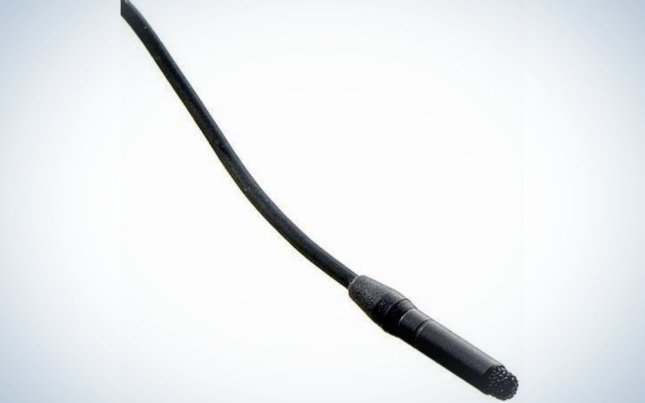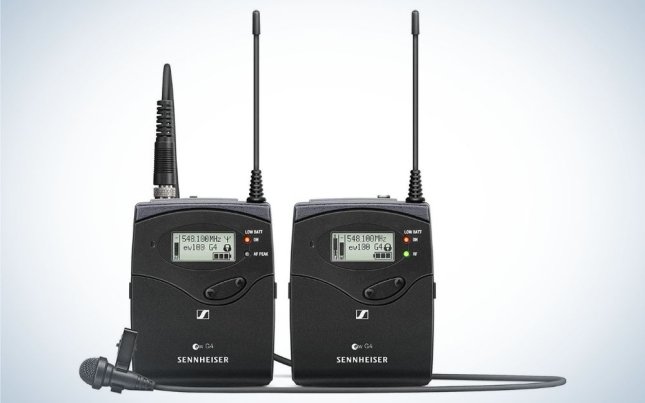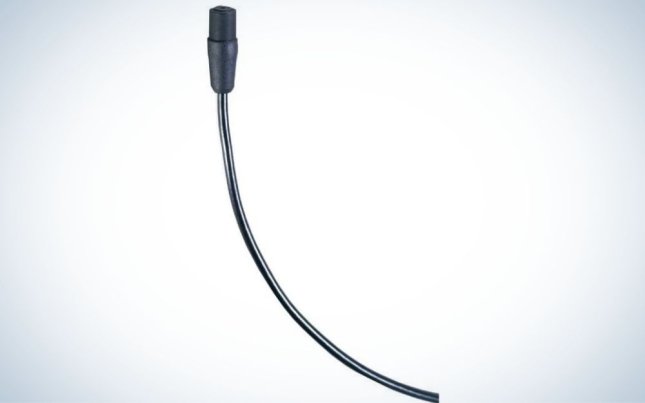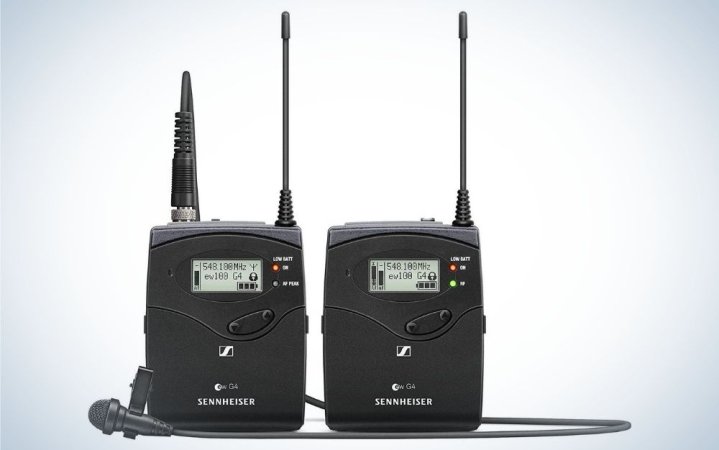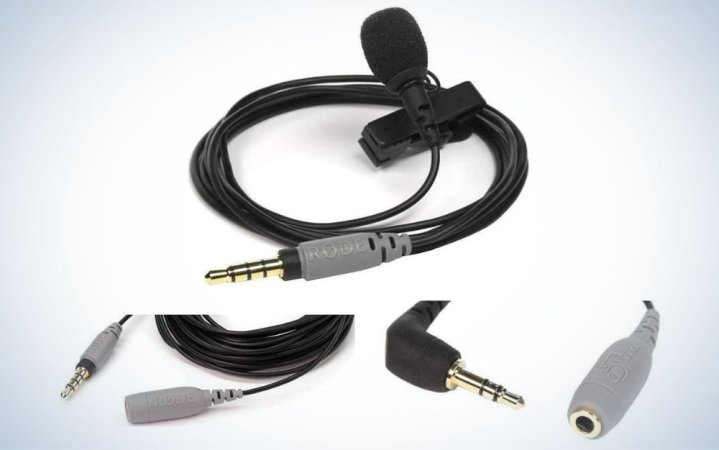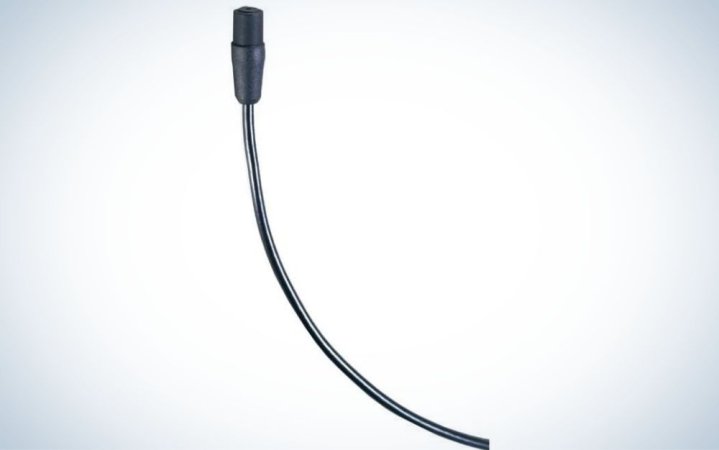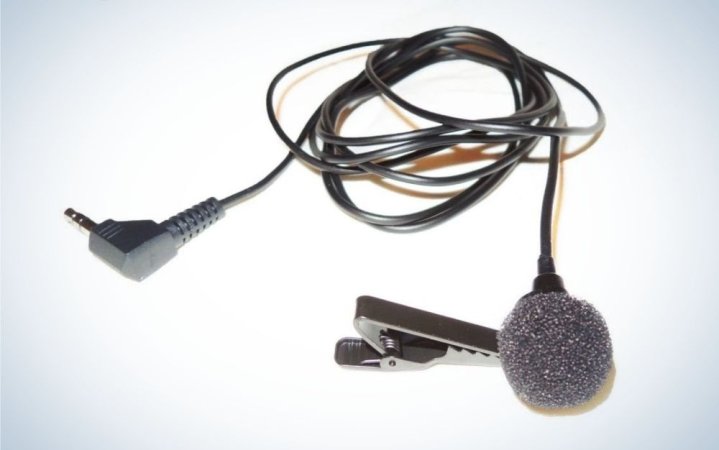We may earn revenue from the products available on this page and participate in affiliate programs. Learn more ›
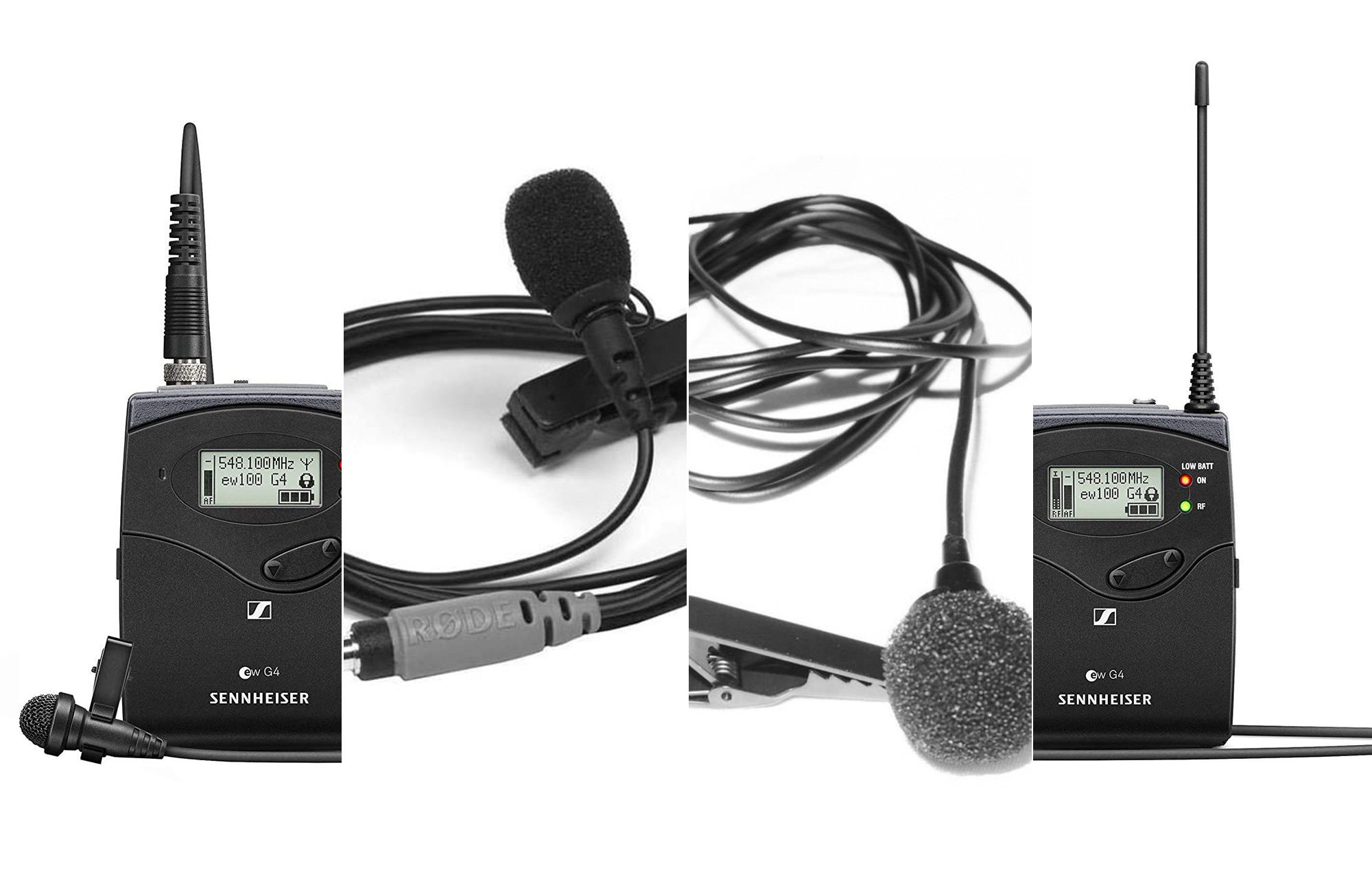
Lavalier mics capture clear and clean audio in a small and lightweight package while leaving people’s hands free for other things. It’s a simple mission, and whether they’re used on a movie set, news broadcast, live presentation, or podcast, these ubiquitous clip-on mics have performed it well for decades.
Lavaliers—also commonly known as a lapel mic, body mic, or, simply, a lav—come in wired varieties that plug into a power source and then directly into a recorder, computer, mixer, or PA system. Wireless models rely on a small transmitter and receiver pack that allow wearers a full range of unencumbered movement. Both can sound excellent, and choosing the right one depends entirely on your goals.
Lavs have a place in any dedicated audio kit, studio, or camera bag—or attached to your computer for Zoom meetings. And because they’re available at a variety of price points, you don’t need to be a professional sound engineer to afford one. We’ve assembled five of the best lavalier microphones to help you cut through the noise and find the one that best suits your needs.
- Best lavalier mic: Sanken Cos-11D
- Best for DSLR: Sennheiser EW 112P G4
- Best for iPhone: Rode smartLav+
- Best mic for streaming: Audio Technica AT899
- Best budget: Giant Squid Audio Labs
How we chose the best lavalier mics
When considering which lavalier microphones to include in our recommendations, we relied on our own experience and also consulted with other professionals in the film, TV, streaming, and recording worlds to find out which mics they use. We read trade journals and websites and checked online impressions to see what typical users thought of the equipment. We narrowed the field down to 10 excellent microphones, focusing first and foremost on audio quality and then considering size, types of connectors, power sources, and, of course, price. When evaluating wireless kits, we evaluated the quality of the lav first and then looked at transmitter and receiver specs to check things like the robustness of their signals, their effectiveness in handling interference, and the flexibility of their features.
The best lavalier mics: Reviews & Recommendations
Best overall: Sanken Cos-11D
Best overall
Pros
- Natural, open sound
- Small and easy to hide
- Picks up very little clothing rustle
- Resistant to sweat and moisture
Cons
- More expensive than many lavs
Why it made the cut: This professional-grade microphone captures the human voice without noticeable coloration, and its small size makes it easy to hide. No wonder you’ll find the Cos-11D on many TV and movie sets.
Specs
- Frequency Range: 50Hz-20kHz
- Connection Type: XLR-3M, Locking 3.5mm TRS
- Polar Pattern: Omni-Directional
The Sanken Cos-11D condenser mic has a frequency response of 50Hz to 20kHz and captures wide, open, and natural sound. This 4mm lavalier hides easily under clothes, and a small boost in the upper-mid frequencies helps to counter any muffling effect.
With an omnidirectional polar pattern, the mic captures audio clearly even when positioned off-axis—it’s pretty forgiving when not placed perfectly. A built-in mesh screen helps resist RF interference while also providing a fair degree of protection against sweat and smeary makeup. Sanken makes the lapel mic in various connector configurations to fit any use and it comes with an alligator clip; small snap-on windscreen; and plastic sleeve to help when mounting it under clothes.
Finding fault with the Cos-11D isn’t easy, but this level of quality comes with a higher price tag. If your budget isn’t there yet, or your applications just aren’t as demanding as the professional broadcast world, other mics can deliver excellent sound in almost as small a package for less money.
Best for DSLR: Sennheiser EW 112P G4
Best For DSLR
Pros
- Rugged construction
- Easy to set up
- Comes with transmitter and receiver
Cons
- Requires a lot of batteries
- Audio can sound somewhat boxy
Why it made the cut: Sennheiser pairs their excellent ME2-II microphone with a flexible wireless transmitter and receiver for a kit that won’t tie up filmmakers or streamers with extra cables.
Specs
- Frequency Range: 50Hz-18kHz
- Connection Type: Locking 3.5mm TRS
- Polar Pattern: Omni-Directional
Sennheiser’s EW112P wireless kit includes their ME2-II omnidirectional microphone, a wireless transmitter, and receiver. It’s a clean-sounding, affordable kit that’s become a workhorse on indie films, documentaries, live presentations, worship services, business events—basically, any situation where movement is key. The 5.6-ounce receiver won’t weigh down your digital single-lens reflex (DSLR) camera and the transmitter easily slips into a pocket or clips to a belt.
The microphone 50Hz to 18Khz frequency response doesn’t match those found on higher-end, professional lavaliers. But it still performs well without coloring the sound too much or adding mud to the low-end. The mic handles sudden boosts in volume well. Like other mics with omnidirectional polar patterns, the ME2-II isn’t picky about where you place it. However, it’s susceptible to rustling from clothes, so be careful if trying to hide it.
The plastic and metal transmitter sends a signal up to 330 feet and features 1680 RF channels to help you avoid interference from other wireless sources. Digital displays on both the transmitter and receiver provide information on battery status, output level, and RF level. Each runs on convenient AA batteries, though you’ll want to buy a lot of them—best practices are that you change batteries before each shoot just to be safe. The kit includes cables terminating in both XLR and 3.5 TRS jacks for connecting the receiver to any kind of camera, as well as a convenient, plastic cold-shoe mount.
Best for iPhone: Rode smartLav+
Best for iPhone
Pros
- Kevlar-reinforced cable resists stretching and tearing
- Included pop filter to cut down on plosive B and P sounds
- Custom iPhone recording app
- Compatible with third-party recording apps
Cons
- May require a TRRS-to-TRS adapter for use with some DSLRs.
- No version of Rode’s app for Android devices
Why it made the cut: The smartLav+ includes Rode’s iPhone recording app that features editing functions and EQ settings, and can export files to SoundCloud and Dropbox.
Specs
- Frequency Range: 20Hz-20kHz
- Connection Type: 3.5mm TRRS
- Polar Pattern: Omni-Directional
Rode has a reputation for building affordable, high-quality mics. The smartLav+ plugs into an iPhone and you can use the company’s custom app to record, edit, and upload your audio. It’s great for anyone looking for a simple, streamlined recording solution that doesn’t require additional equipment. This body mic will work with Android phones as well, but you’ll need a third-party app. You can also plug it into DSLRs and mirrorless cameras, but you consult the camera’s manual to see if you’ll also need a TRRS-to-TRS adapter.
As expected, this omnidirectional microphone picks up sound from all sides for easy use. It comes with a pop-filter to cut down on plosives—the hard B, P, and T sounds that can wreak havoc on a recording. Kevlar-reinforcing protects the cable from snapping, and the included mic mount includes an extra clip to help with wire management.
Best mic for streaming: Audio Technica AT899
Best Mic For Streaming
Pros
- Professional-quality sound
- Small profile
- Multiple power options
- Includes battery pack
Cons
- Moderately expensive
Why It made the cut: The AT899’s small profile won’t distract your viewers, and it works off an included battery pack or 48v phantom power, making it easy to integrate into any type of streaming studio.
Specs
- Frequency Range: 20Hz-20kHz
- Connection Type: XLR
- Polar Pattern: Omni-Directional
The AT899 is a wired lavalier that offers professional-quality sound in a small, flexible package suitable for any streaming studio. The included power-pack connects the mic to any device, including computer interfaces, mobile recorders, or cameras. But this lav also supports 48-volt phantom power for streamlined integration into higher-end mixing consoles, streaming interfaces, or pre-amps.
The low-profile 5mm hides easily under clothes; but even when exposed, it’s small enough that it won’t distract your audience. A wide, flat 20Hz-20kHz frequency response captures the nuances of the human voice and an omnidirectional polar pattern offers flexibility.
You’ll need an XLR to 3.5mm TRS adapter if you want to plug it directly into a DSLR or computer without a balanced audio interface.
Best budget: Giant Squid Audio Labs
Best On a Budget
Pros
- Good sounding for a sub-$100 mic
- Convenient six-foot cord
- Low price
Cons
- Windscreen falls off easily
- Needs a TRRS adapter for smartphone use
Why it made the cut: This lavalier from Giant Squid Audio Labs has a low price and surprisingly wide frequency response, making it ideal for people with tight budgets.
Specs
- Frequency Range: 20Hz-20kHz
- Connection Type: 3.5mm TRS
- Polar Pattern: Omni-Directional
With microphones, you often get what you pay for. However, Giant Squid Labs has done a nice job of delivering a reasonably flat-sounding lavalier for less than $50. Does it compete with a Sanken Cos-11D? Of course not—but the Sanken is about eight times the price. Still, Giant Squid Labs’ 20Hz-20kHz frequency response captures reasonably natural sound—even if it lacks a lot of the presence found in higher-end mics.
This budget lapel mic comes with an alligator clip, small windscreen, and a 6-foot cord. The latter is nice; no one looks great in a Zoom meeting when sitting too close to a web camera. And the windscreen helps cut down on noise when using the mic outside. However, it falls off easily, so consider avoiding heavy winds. The mic connects to a computer or other device using a 3.5mm TRS connector. If you want to use it with a smartphone, you’ll need a TRS-to-TRRS adapter.
Things to consider before buying the best lavalier mics
Wired or wireless
Lavalier microphones come in two basic varieties: Wired and wireless. Wired lavs connect to a small power source (usually an AA battery pack) that plugs into a recorder, PA system, or computer interface. It’s a strong signal path that won’t suffer from any interference. However, the length of the mic cable limits the wearer’s movement.
Wireless lavaliers plug into a small, wearable transmitter that sends the audio signal to a receiver plugged into a recorder or PA system. Wireless lavaliers provide complete freedom of movement, making them useful for video projects or presentations. While the transmitters and receivers have adjustable channels and frequencies to help avoid interference, sometimes they’ll still run into trouble in areas with too many other wireless systems.
Pick-up pattern
Microphones have something called pick-up (or polar) patterns, which describe the way mics capture or reject sound. Most lavaliers have either omnidirectional or cardioid patterns. The first picks up sound evenly from all sides, a handy trick when there’s no way to perfectly position the mic. An omnidirectional mic attached to someone’s collar will capture sound almost as well as one placed on a lapel or tie. Mics with cardioid patterns, on the other hand, are directional, requiring more careful placement—make sure they’re pointed toward the speaker’s mouth. A less forgiving mic might sound like a big drawback, but because cardioid patterns are better at rejecting sound from the sides, these lavs work well in noisy spaces. When purchasing a body mic, think hard about the environment where you’ll use it the most.
Power
Many lavaliers are condenser mics, and condensers need external power to operate. And let’s not forget, wireless mics require power for their transmitters and receivers. In either case, most of these body mics, as well as transmitters and receivers, run off AA batteries. Best practices say to change batteries before each use to avoid the risk of bad audio—or transmitters that drop signals entirely. Be prepared to stock up on AAs, and factor that into your budget. Good quality rechargeables will cost more at the outset, but they will cut costs and waste in the long run.
Some lavaliers also accept 48+ volt phantom power from recorders, mixers, cameras, or other sources. These also have battery packs for use with other equipment. And other mics, like Rode’s smartLav+, can draw power through their 3.5mm jack.
Connectors
The wires connected to lavaliers can terminate in a number of different jacks, including XLR, 3.5-inch TRS, and 3.5-inch TRRS for use with smartphones. Many companies manufacture their best clip-on mics in a variety of jack configurations.
Durability
Lavaliers often take a lot of abuse. Not only can they get banged around, but their wires get twisted, and they’re sometimes attached to sweaty bodies. The best clip-on mics are durably built with at least a nod toward protecting them from low levels of moisture. Don’t submerge them, but don’t be afraid to attach them to someone who might be working in the sun all day.
Attachments
Clip-on mics can attach to people in a variety of ways. Alligator-style clips are common and use a loop made from metal or rubber to hold the mic in place. If you don’t have anywhere to clip something like that, vampire clips use two small pins to attach the mic to clothing (hence the name). There are also magnetic attachments, which have a small metal disk that gets placed inside a shirt, and a small, magnetized loop that connects to it and holds the mic. Third-party manufacturers also make small foam or plastic sleeves that encase mics to minimize the rustling noise when hidden under clothes. Most lavaliers come with at least some basic attachments, but when buying others, find one that isn’t too big or small for your lav.
FAQs
The most important feature when choosing a good lavalier mic is sound quality. After that, consider how you’ll use it. Do you need something small and easy to hide? Wireless? How rugged should it be? Finally, consider your budget. Generally, cost tends to reflect microphone quality—you get what you pay for, and it’s worth spending a bit more for a reputable piece of equipment that delivers quality over the life of its use.
Lavalier mics sound good when used correctly, and in circumstances that warrant their use. If you’re recording a podcast, stage performance, broadcast, or video, they can sound great! In many cases, you’ll want to place them close to the breastbone, which allows the mic to pick up the naturally resonating frequencies of the human voice. However, some mics are meant to be worn on the head using earpieces or other methods—obviously, placement matters to get the most out of them.
You can use a lavalier mic for Zoom as long as you have a way to plug it into your computer. This might mean buying an adapter if your lav uses an XLR connector, or perhaps you’ll have to use an audio interface with your computer. If your clip-on microphone doesn’t include its own power source, make sure the computer’s audio input also sends power.
Lavalier mics are great for filmmaking. They’re often used in the film and TV industry, especially when a boom mic isn’t practical. Documentary makers use them all the time, too. In fact, many audio engineers will use both a lav and a boom in order to make sure they capture the best sound they can.
The price of a lavalier depends on many factors. Some lavs cost as little as $25, but don’t expect the best sound or build quality. At the high end, lavs sell for hundreds of dollars and deliver professional sound under demanding conditions. Perfectly serviceable lavs can be found for less than $75, but if you want something approaching professional quality, expect to pay $150 or more (sometimes much more).
Lavalier mics do not need phantom power, per se, but they do need power. It can be phantom power, but it can also come in the form of an in-line battery pack using AA batteries, or the batteries inside a wireless mic’s transmitter.
A lavalier mic will last many years if treated properly. Like all high-end equipment, make sure to store it safely when not in use. Be particularly careful when winding the mic’s cord—don’t force it into too tight a loop or you risk breaking the wire. Keep battery packs or wireless units clean and dry, and try to avoid dropping them. They’re usually robust, but not indestructible. Microphones are an investment, and when treated well, they’ll continue to pay back with great audio.
Final thoughts on the best lavalier mics
- Best lavalier mic: Sanken Cos-11D
- Best for DSLR: Sennheiser EW 112P G4
- Best for iPhone: Rode smartLav+
- Best mic for streaming: Audio Technica AT899
- Best budget: Giant Squid Audio Labs
If you’re looking for the cleanest, clearest, professional-quality lavalier for your film or streaming program, and you’re not worried about your budget, then I absolutely recommend the Sanken Cos-11D. It’s become my go-to mic on documentaries and TV shows, and I often pair it with a Sennheiser wireless transmitter and receiver for the most flexibility.
But I’ve also used mics that cost a third as much. Before I upgraded to the Sanken, I was happy with the Sennheiser ME2-II lav that comes in the EW 112P G4 wireless kit. As long as I placed it carefully and watched my levels, it never let me down. I still carry it in my kit as a backup.
In the end, great equipment won’t do much if you don’t know how to use it. Take the time to learn proper miking techniques and develop your skills.
